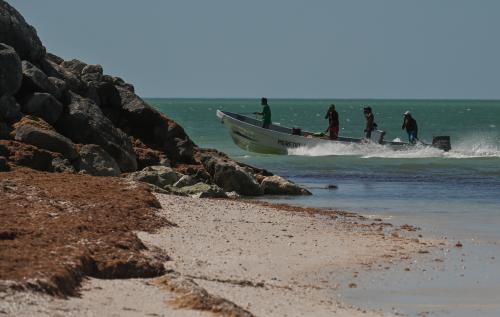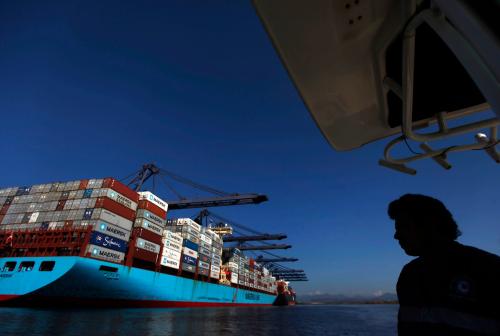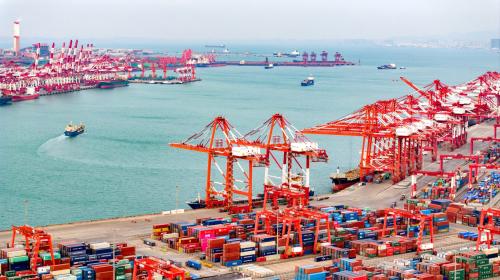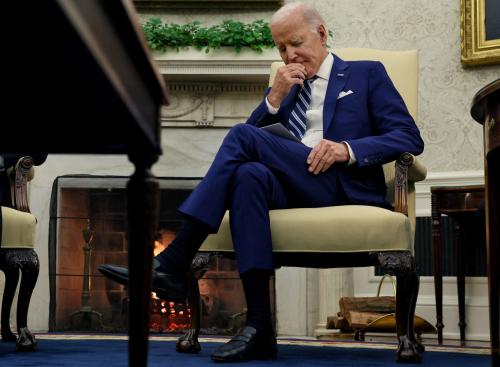Vanda Felbab-Brown describes the struggles of a community of fishers in Mexico who tried to go straight and embraced sustainable fishing and conservation only to see two decades of their efforts threatened by organized crime. This piece was originally published by Mexico Today.
The craggy-faced fisherman rolled his water and ice cubes filled glass in his hand again, looking in the direction of the sea, before finally, after a long pause, lifting his eye to me – with sadness, embarrassment, desperation: “It’s really very difficult. Because the cartels, they have more power than the government. They really make you afraid of them.”
In my last op-ed in Mexico Today, I laid out a broad picture of how organized crime groups in Mexico – principally the Sinaloa Cartel and Cartel Jalisco Nueva Generación – are taking over the entire vertical chains of legal and illegal fisheries in Mexico. In this op-ed in a three-part series, I describe the struggles of a community of fishers in Mexico who tried to go straight and embraced sustainable fishing and conservation only to see two decades of their efforts threatened by organized crime. I interviewed the community representatives in Baja California Sur (BCS) in November 2021 with the promise I would not use their names, give the location of the community, or even identify the seafood product they were harvesting since they believed that alone would allow the cartels to trace the conversation to them and they could be killed.
The community of 600 residents sprawls out along an azure bay, far north from the places to which American tourists head in BCS. Instead of posh hotels and snazzy restaurants, there is an unappealing factory on the coast. In the 1950s, the factory began filling up and draining the coastal mangroves, a key ecosystem habitat, a nursery for the bay’s rich marine life. Along with the pressure on the habitat and vital ecosystem services came illegal fishing. A lot of illegal fishing. Most of the men in the community became illegal fishers, catching from their rackety pangas (small boats) without a license in a protected marine park. The illegal catch kept the community economically afloat, but didn’t allow it to break out from poverty or petty crime.
After decades of environmental degradation and illegal offtake, a NGO started in 2008 to work with the community on restoring the mangroves, building sustainable aquaculture projecting, and persuading the community to stop fishing illegally.
The effort was hard-going: for several years, many of the fishers did not trust that the aquaculture could bring in enough money. They thought the NGO was selling pipe dreams and would abandon the community. When finally some of the men and women started working with the NGO, other members of the community threatened them. Those who signed up to the sustainability projects had to develop ways to control and persuade the armed resisting community members who continued fishing illegally, some hooked on drugs.
But the hard work paid off. In 2017, the community was awarded legal permits for its 2400 hectares of aquaculture and sustainable fishing. The income was good, petty criminality declined, and dreams and plans began about diversifying the local economic activities into tourism.
Then in 2018, an invasive species devastated 90 percent of their aquaculture projects. Not just the income, but also the spirit of the community were crushed.
Still, the community, with steadfast support of the NGO, rallied and started rebuilding the aquaculture and adapting it to cope better with invasive species.
Things started looking up again, but then another blow in 2019: Although the community had been granted the fishing and aquaculture licenses and had been restoring the mangroves, it did not own the mangroves areas and coastal land around their aquaculture projects. Access to them had been permitted by the landowner, a wealthy business corporation. But now the corporation noticed the physical visual improvements in the area, and it too started imagining developing tourism business there. Along the coast, in the community’s access points to its aquaculture projects, it began opening coffeeshops and restaurants and no longer cared to have smelly cages and dirty aquaculture work under the noses and eyes of the tourists it sought to attract. The corporation booted the community out of its land and the fishers had to move their aquaculture projects away. But once again, the community persevered and mostly stayed away from illegal fishing.
Then in March 2021, the narcos returned into the area. The fishers had heard about other communities in BCS and the neighboring state of Baja California being taken over by the drug groups, but thought they were too insignificant for the organized crime groups to bother with them. After all, the community was not around a strategic port, useable for drug trafficking, like San Carlos, for example. Nor were the community’s financial aquaculture pickings anywhere on par with what big fishing BSC businesses – extorted and taken over by the cartels – would bring in.
Still, this was not the first time the community had encountered organized crime. Between 2015 and 2018, the Sinaloa Cartel was battling against a splinter faction in cahoots with the CJNG over the BCS extortion and drug turfs. The violence spilled into the fishers’ community: community members, mostly users looking for a way to feed their habit, who sold pot or meth for one cartel, were targeted by sicarios of the rival cartel. Several dealers in the community got killed. But then Sinaloa won in BCS, and the violence quieted down, even though crystal meth use and its devastation in the community persisted.
But this time, the narcos behaved differently. They were no longer just interested in the local drug distribution: They were after a much broader take. Two trucks with the fishers’ catch were stopped by the cartel men. The narcos stole all of their fish and told the drivers that from now on they would have to pay the narcosextortion fees on all of their catch and sales.
Yet the narco pressure didn’t stop there. A few weeks later, a sister-in-law of one of my interlocutors, en route to a nearby port to sell her seafood, was stopped by the cartel men and told she could no longer sell to whom she wanted. From then on, she would have to sell all her seafood only to the cartel. If she resisted, she would be tortured her, and along, with her family, disappeared.
Terrified, the community got together to mull what to do. Fears ran high. But at the community meeting, one man with a business, my interlocutors recounted, stated: “I won’t deal with the narcos, I am protected by god. We should resist.” Within days, the organized crime group burned his business. Undeterred, he reopened it, still refusing to pay piso. The cartel killed him.
Worse, it emerged his nephew was working for the criminal group. In its takeover of the community, the cartel did something insidious, and brutally effective. It had recruited cartel members from within the community, at first approaching those who had persisted in illegally fishing undersized lobsters and paying these fishers top money for a low-value product.
Moreover, unlike in 2015, this time, community members were not recruited by the cartel just to sell drugs, but also to monitor the community and report any efforts to organize resistance. The cartel also started encouraging fishers to the return to illegal fishing, promising to protect them and buy their harvest.
The community understood that its internal fragmentation was its biggest vulnerability. Instead of rejecting those recruited by the cartel, community leaders approached them, arguing that if the community started selling fish to the narcos, it would lose its aquaculture and fishing licenses and support from NGOs. It would lose its legal fishing income, its dreams of running a tourism business.
The narcos upped the pressure, killing the son-in-law and grandson of one of the community organizers, one of my interlocutors. Still, the community had not buckled. Again, the sustainable fishery leaders approached community members recruited by the cartels, trying to persuade them to break with the cartel and tell the cartel to leave. A female interlocutor of mine, a wife of a fisherman recounted that meeting: “I went to them. I said we don’t want to reject you. Stay with us. I am proud of our life. I am proud to be a wife of a fisherman. If the community loses cohesion, it will lose its spirit, its pride in what we accomplished, its identity.”
But the cartel recruits were now too scared of the cartel to break away and tempted by visions of crime riches. The cartel didn’t leave, instead upping the pressure on the community: While at first, it only sought to monopolize the purchases of high-value seafood products, now it insisted the community had to sell all of its seafood to the cartel.
But it was worse than that, another of my female interlocutors confided: “The narcos want to intimidate us, they want us to be afraid, so they can control every aspect of our lives.”
The community never had much positive dealing with the government or law enforcement forces. But desperate now, it welcomed the arrival of the National Guard that in August 2021 began occasional patrols in the area. The community hoped the National Guard would liberate it from the narcos, force the narcos out. No such thing happened. The Guard hang out on the streets every so often, its presence dwindling in time, while the narcos remained in the community, often showing up right on the heels of the National Guard’s patrol vehicles. And the cartel’s extortion, threats, and demands of purchase monopolies did not abate. The community soured on the National Guard, first finding it useless, later on suspecting it might be working with the cartel.
The craggy-faced fisher rolled the glass in his hands again, all ice in the water having dissolved. “We allowed organized crime to come in because we never denounced them to the government,” he stated slowly. “I feel complicit that I hadn’t reported them when they first came in 2015. I thought as long as the organized crime doesn’t touch me, I have no problem with organized crime. But that was a mistake. One day it would touch me. It touches all of my life now, and there is no escape. Organized crime here is like a wildfire. If you just run without trying to extinguish it, sooner or later it will catch you. But tell me, how do we resist if the government does not back us up?”







Commentary
Op-ed“How do we resist?” – Organized crime is taking over Mexican fisheries, part II
March 6, 2022